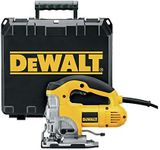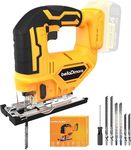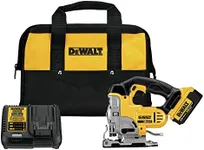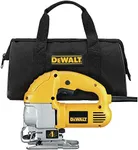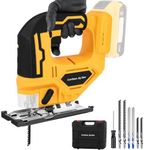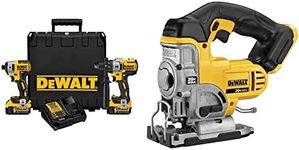Buying Guide for the Best Dewalt Jigsaws
When it comes to picking the right jigsaw, it's important to consider a few key specifications that will help you find the best fit for your needs. Jigsaws are versatile tools used for cutting curves and complex shapes in various materials. Understanding the key specs will ensure you choose a jigsaw that matches your projects and skill level.Power SourceJigsaws can be either corded or cordless. Corded jigsaws are typically more powerful and are ideal for heavy-duty tasks and prolonged use, as they provide a constant power supply. Cordless jigsaws offer greater mobility and convenience, making them suitable for on-the-go projects or areas without easy access to power outlets. If you need a jigsaw for extensive, continuous work, a corded model might be best. For occasional use or portability, a cordless jigsaw is a great choice.
Motor PowerMotor power in jigsaws is measured in amps for corded models and volts for cordless models. Higher motor power means the jigsaw can handle tougher materials and more demanding tasks. For light to medium-duty work, a jigsaw with 4-5 amps (corded) or 18-20 volts (cordless) should suffice. For heavy-duty tasks, look for jigsaws with 6-7 amps or higher. Consider the types of materials and the thickness you will be cutting to determine the right motor power for your needs.
Stroke RateThe stroke rate, measured in strokes per minute (SPM), indicates how fast the blade moves up and down. Higher stroke rates allow for faster cutting, while lower stroke rates provide more control for detailed work. Variable speed jigsaws let you adjust the stroke rate to match the material and the precision required. For general use, a jigsaw with a variable speed range of 500-3,000 SPM is versatile. Choose a jigsaw with adjustable speed if you plan to work on different materials and need flexibility.
Orbital ActionOrbital action refers to the elliptical motion of the blade, which can make cutting faster and more aggressive. Jigsaws with orbital action settings allow you to adjust the blade's movement for different materials and cutting styles. Lower orbital settings are better for smooth, precise cuts in materials like metal or hardwood, while higher settings are ideal for faster, rougher cuts in softer materials like plywood. If you need versatility, look for a jigsaw with multiple orbital action settings.
Bevel CapacityBevel capacity indicates the jigsaw's ability to tilt the base plate for making angled cuts, typically up to 45 degrees. This feature is important for tasks that require beveled edges or miter cuts. If you frequently work on projects that involve angled cuts, choose a jigsaw with an easy-to-adjust bevel mechanism and clear angle markings. For general use, a standard bevel capacity of 0-45 degrees should be sufficient.
Blade Change SystemThe blade change system determines how easily you can replace the jigsaw blades. Tool-less blade change systems are the most convenient, allowing you to swap blades quickly without additional tools. This feature is especially useful if you need to change blades frequently for different materials. If you value convenience and efficiency, opt for a jigsaw with a tool-less blade change system.
Dust ManagementDust management features, such as dust blowers and vacuum attachments, help keep your cutting line clear and reduce cleanup time. A built-in dust blower can improve visibility by clearing sawdust from the cutting area, while a vacuum attachment can help maintain a cleaner workspace. If you work indoors or need to keep your work area tidy, consider a jigsaw with effective dust management features.



